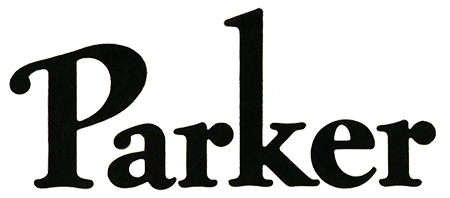Parker True Blues: True Beauties 1928-1931
by Jim Mamoulides February 25, 2002, Updated July 4, 2003 and January 12, 2024
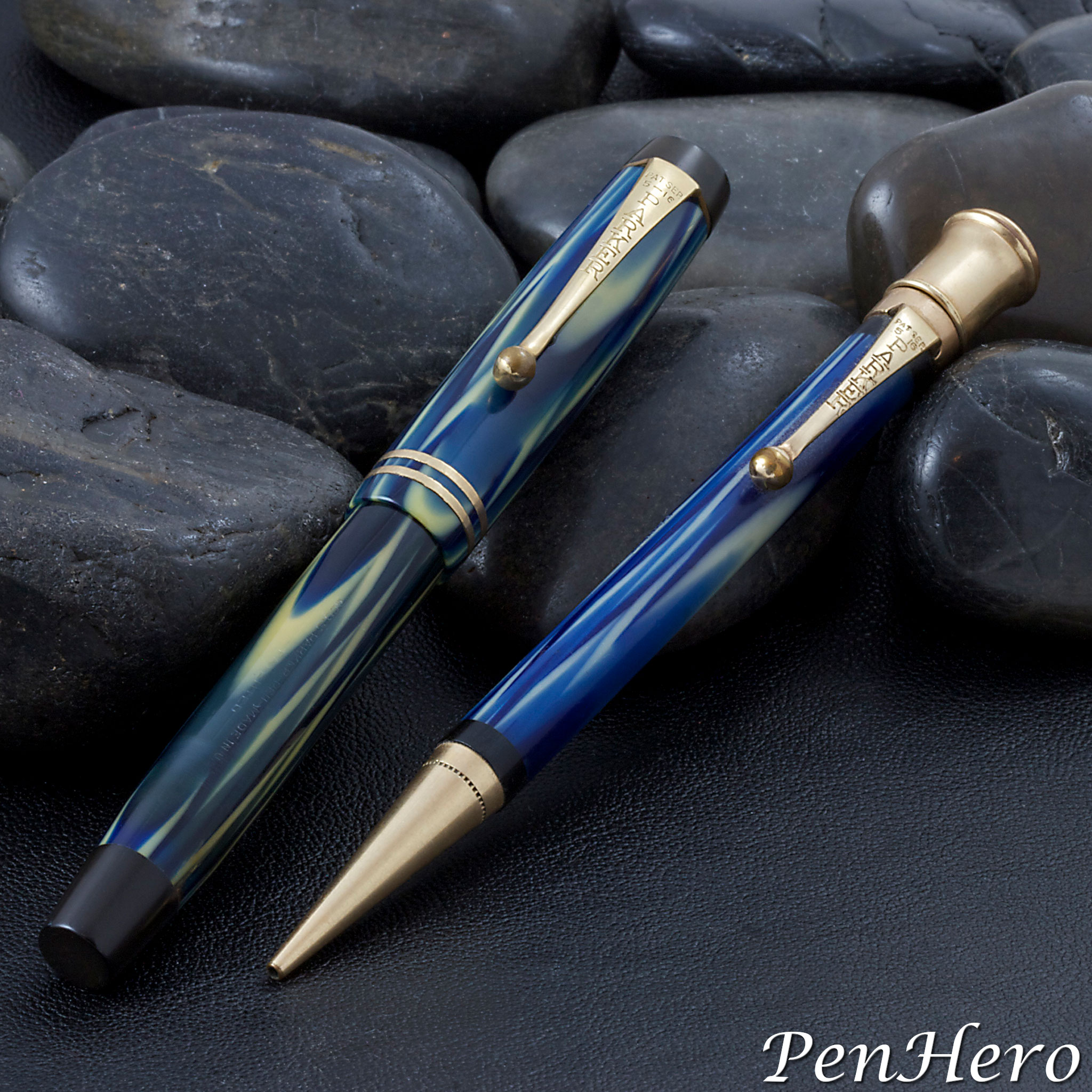 Parker True Blue streamlined junior size pen and pencil
Parker True Blue streamlined junior size pen and pencil
Duofold Quality
Several times in the mid to late 1920s Parker capitalized on the popularity of their highly successful and expensive Duofold brand by introducing similar design lower-priced lines of pens. The first was introduced in 1923 as the linear chased black hard rubber "D. Q." for "Duofold quality" pen line. Early ads for these pens were aimed at the student market, specifically their parents, offering a “higher value” pen for $3.00. The line included a slender clip pen and a ringtop pen at a considerable savings below the $7.00 the Duofold commanded. This new line effectively replaced the Jack Knife pens. The D. Q. had the familiar Lucky Curve imprint on the barrel with Parker “D. Q.” above the Lucky Curve banner logo. Retailer advertisements for D. Q. pens can be seen as late as 1931. The D. Q. was followed in 1926 by the very collectible "Parker Pastels," a line of smaller, colorful Duofold shaped moiré pattern clip and ringtop pens aimed at female buyers and priced at $3.50 each.
A Colorful Pen For The Student Market
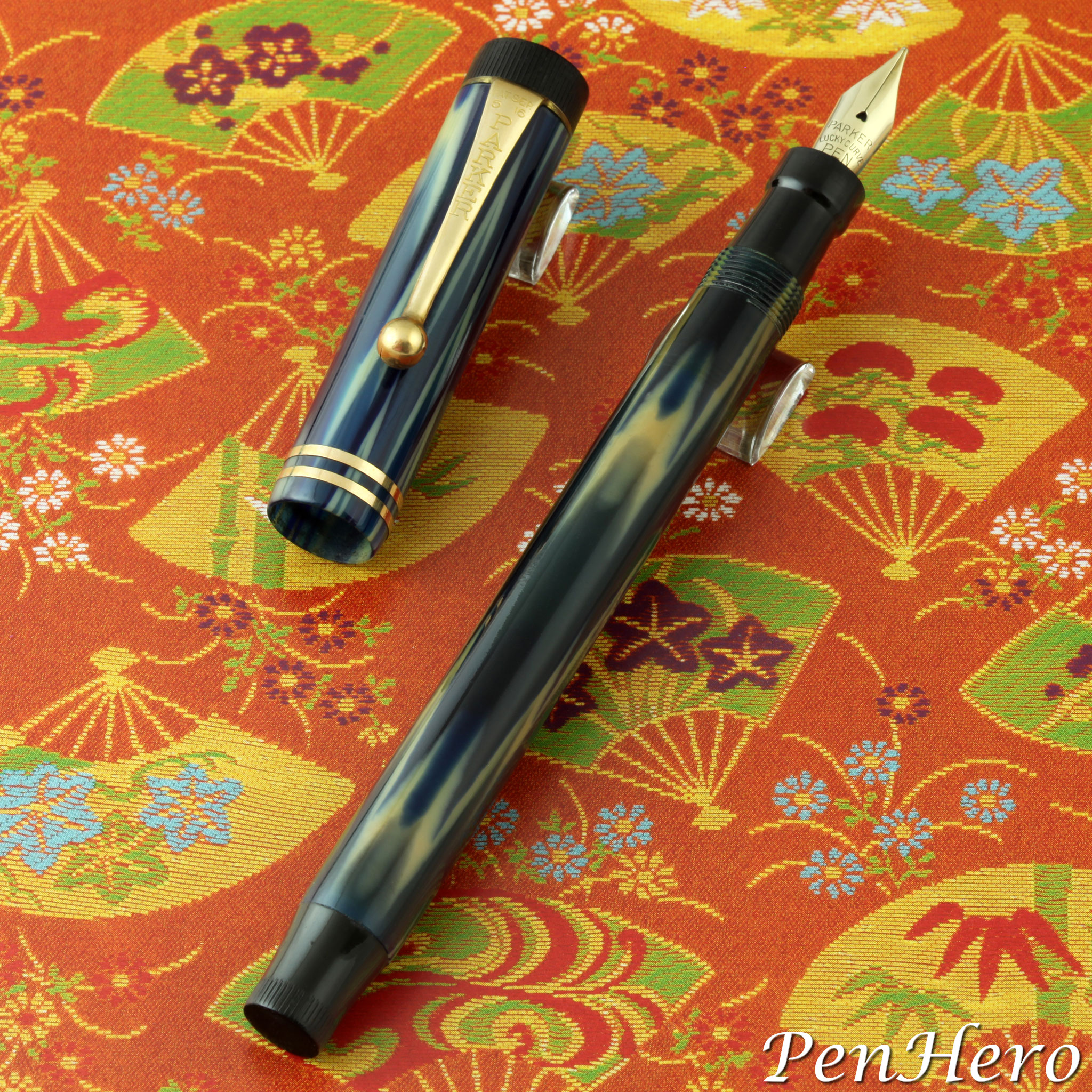 Parker True Blue flattop full size pen
Parker True Blue flattop full size pen
In 1928 Parker introduced one of the most sought after of these low-priced pens, known today by collectors as the "True Blue." This new slender blue and white swirled Permanite celluloid pen was called the "Three Fifty" in early Parker advertisements and the 1929 Parker catalog. The color was called "Modernistic Blue" in 1929 ads and the 1929 Parker Catalog and "True Blue" in 1930 ads and the 1930 Parker Catalog. The new "Three Fifty" was announced in a short article, "Parker Pen Fall Advertising Plans" in the September, 1928 Geyer's Stationer. The article indicates that the new pen line will be available in the fall of 1928. The earliest Parker advertisement I could find showing this new pen line is in the May 19, 1929 Pittsburgh Sun-Telegraph. The True Blue does not appear in the 1932 catalog, indicating that the line probably ran from 1928 through 1931.
1928-29 True Blue Flattop Identification Guide and Features:
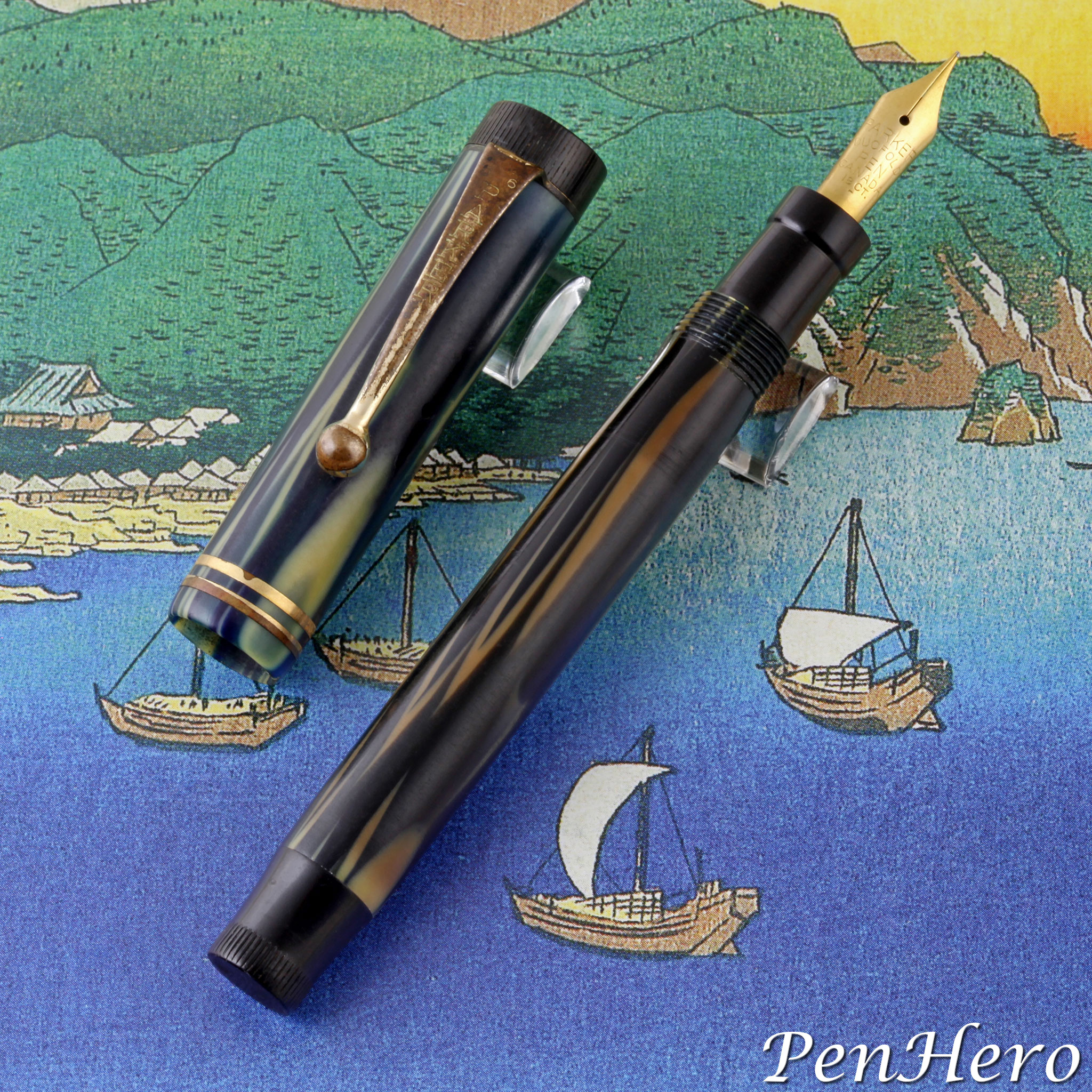 Parker True Blue flattop junior size pen
Parker True Blue flattop junior size pen
The first True Blue pens were flattops, smaller and more slender but similar in design to Parker’s larger Duofold models. The 1929 catalog calls them “Parker “Three-Fifty” Pens in Modernistic Blue.” Parker intended them to have the familiar look of their more expensive pens as a selling point. The pens have the "Lucky Curve" imprint and stamping on the nib. The line has the look of the larger Duofold but are slightly shorter (5 1/4 inches vs. 5 1/2 inches) and more slender.
These first True Blues included a long 5 ¼ inch fountain pen, a short 4 ½ inch fountain pen, and a ringtop fountain pen for $3.50 each and matching pencils at $3.00. The short fountain pen is not in the 1929 catalog, indicating it was added later. The barrel imprint reads GEO. S. PARKER over JANESVILLE, WIS. next to the Lucky Curve logo banner next to FOUNTAIN PEN over U.S.A. PAT. 4-25-11.
- Blue and white marbled celluloid cap and barrel
- Black hard rubber cap top and barrel end cap with knurled ends
- Gold filled clip stamped PARKER with PAT SEP. over 5 16 at the top
- Two gold filled 1/16 inch wide plain cap bands
- Threaded cap
- 14 karat gold nib, stamped PARKER over LUCKY CURVE over PEN over 2
- Six nib grades: extra fine, fine, medium, broad, stub, oblique
- Button filler
- Pen with clip in two sizes, about 5 ¼ and 4 1/2 inches long capped
- Ringtop pen, about 4 1/2 inches long capped
- Fountain pen was $3.50 and matching twist action pencil was $3.00
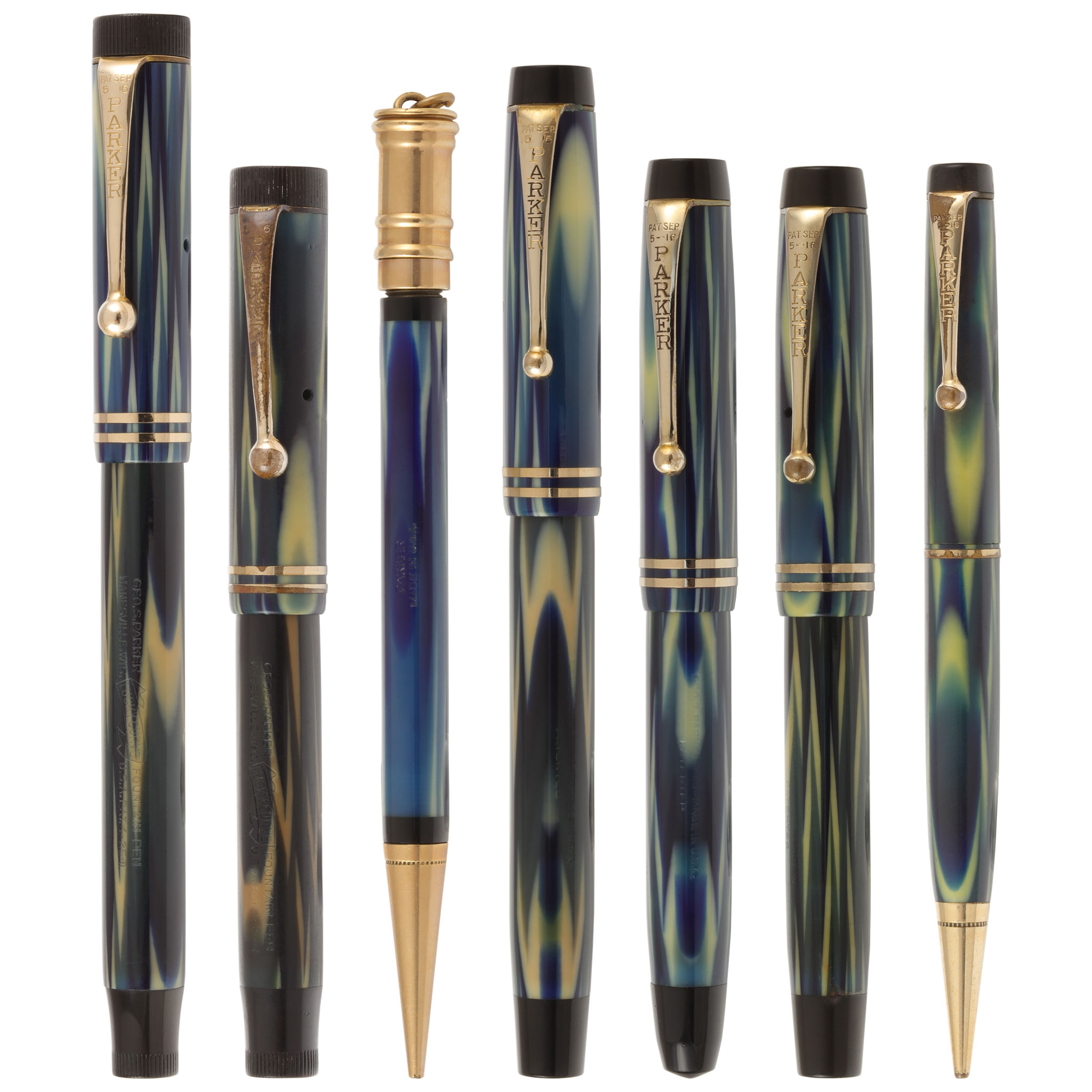 An array of Parker True Blue pens and pencils
An array of Parker True Blue pens and pencils
1930-31 True Blue Streamline Identification Guide and Features:
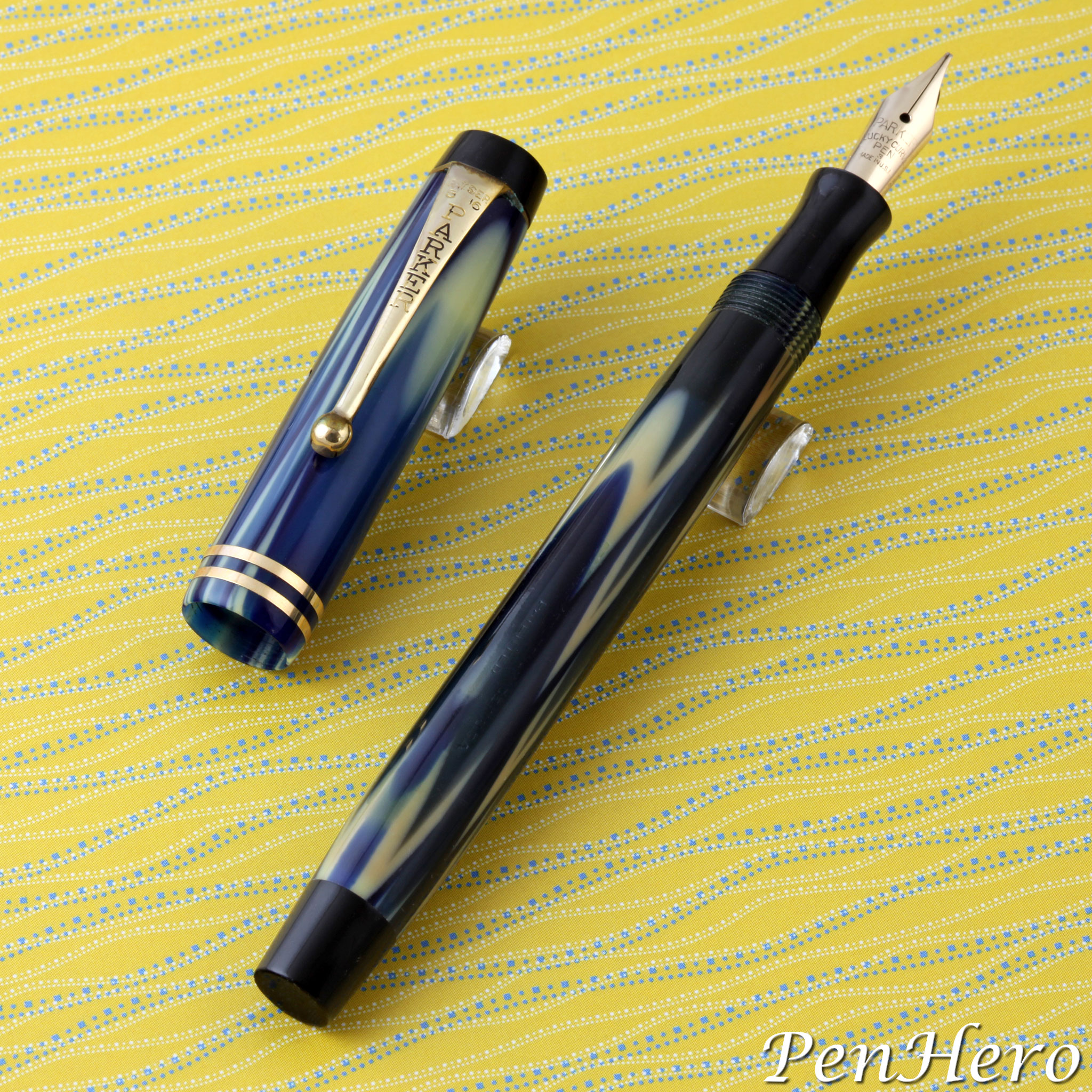 Parker True Blue streamlined full size pen
Parker True Blue streamlined full size pen
When Parker streamlined the Duofold line in late 1929, the True Blue followed suit. The longer streamlined pen is a little shorter than the flattop model, at 5 inches long, but is about the same girth. The junior size pen is the same length as the flattop model. The imprints on the pens are simpler and no longer have the Lucky Curve banner, though most examples observed have Lucky Curve spear feeds and stamped nibs. The barrel imprint reads GEO. S. PARKER – PEN – MADE IN U.S.A. over PATENTED.
- Blue and white marbled celluloid cap and barrel
- Black hard rubber cap top and barrel end cap
- Gold filled clip stamped PARKER with PAT SEP. over 5 16 at the top
- Two gold filled 1/16 inch wide plain cap bands
- Threaded cap
- 14 karat gold nib, stamped PARKER over LUCKY CURVE over PEN over 3 over MADE IN over U.S.A.
- Six nib grades: extra fine, fine, medium, broad, stub, oblique
- Button filler
- Pen with clip in two sizes, about 5 and 4 1/2 inches long capped
- Ringtop pen, about 4 1/2 inches long capped
- Fountain pen was $3.50 and matching twist action pencil was $3.00
The True Blue line likely ceased production by 1931 as it does not appear in the 1932 Parker catalog nor in ads from that year. It’s not known how well the True Blue line sold, but they are not as common as the larger Duofold pens. This could be that they were aimed at students and suffered hard use and discarded when replaced.
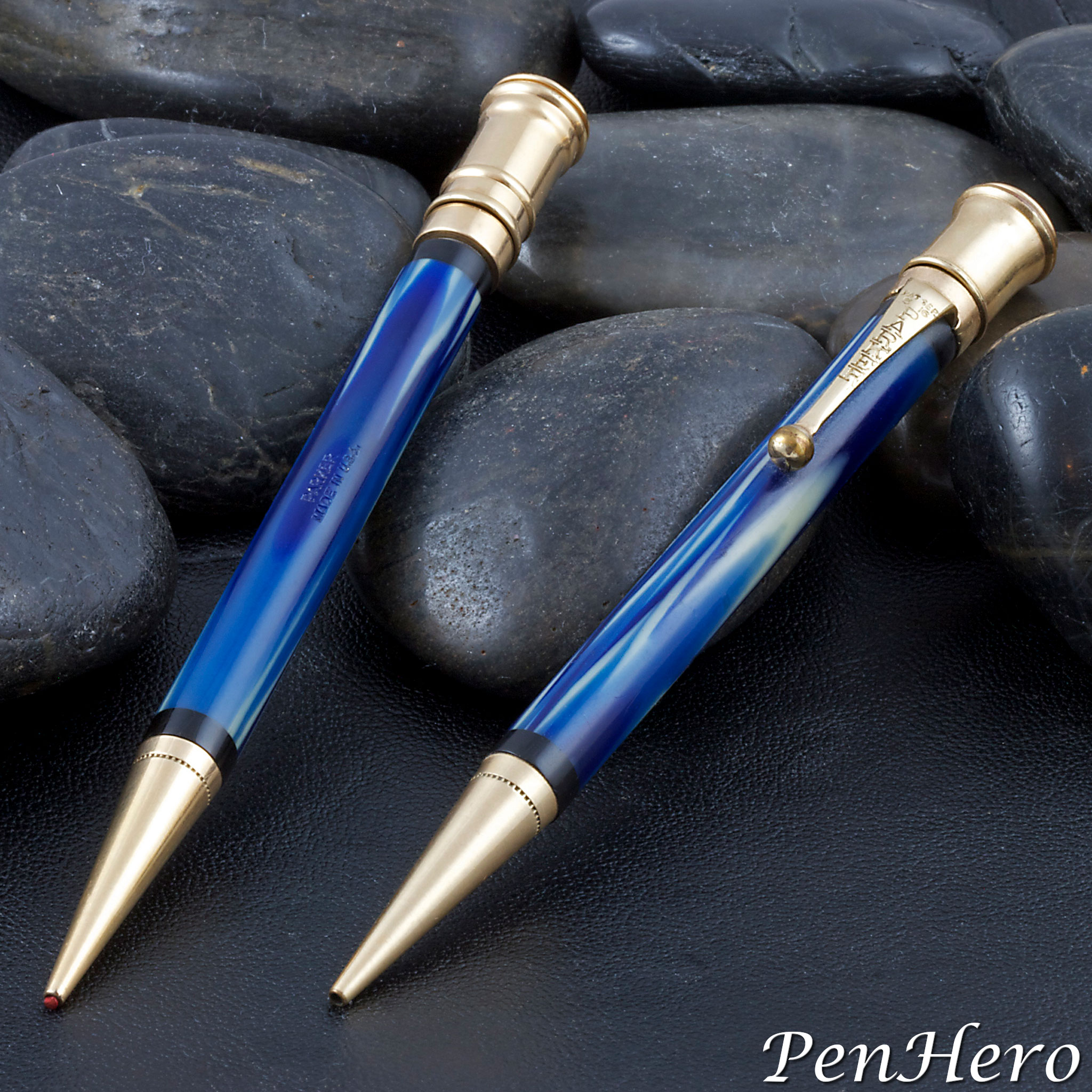 Parker True Blue pencils, with clip and ringtop
Parker True Blue pencils, with clip and ringtop
As with many Parker Permanite pens, True Blues are highly susceptible to discoloration. It's not known exactly what the chemical process is, but the presence of ink in the rubber sac appears to activate the sulfur vapor which escapes and initiates and accelerates discoloration of the celluloid. True Blues are very often seen with strong variation in color between the cap and barrel. Caps tend to retain the original color better, a bright blue and cream white swirl, where discoloration tends to amber the barrel white in strong contrast to the cap. Mint True Blues are rare and will be quite pricey. Even moderately discolored True Blues will sell for similar prices as excellent Big Reds. The pencils tend to show the original color better than the pens as they don’t have the ink reaction.
Performance
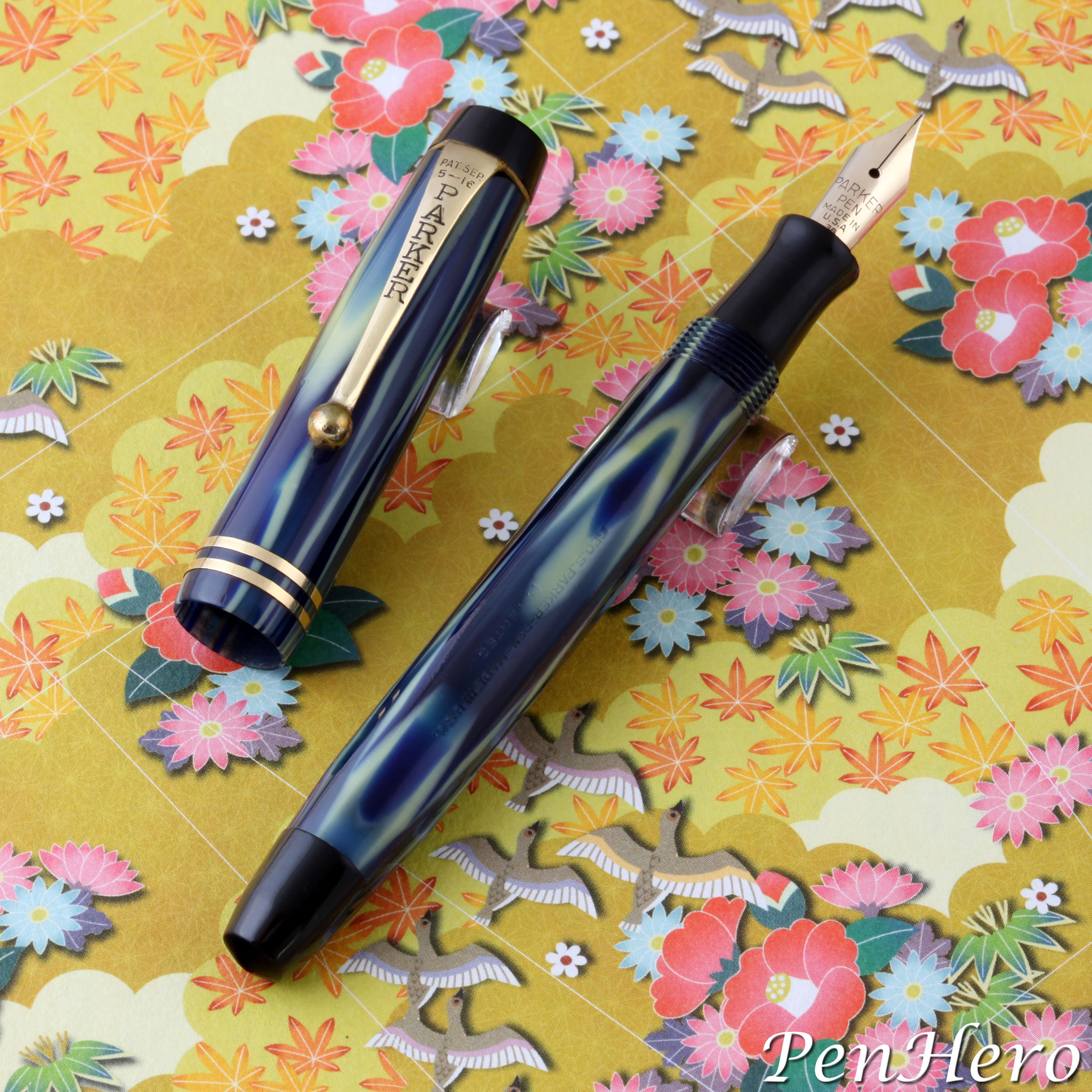 Parker True Blue streamlined junior size pen
Parker True Blue streamlined junior size pen
I sampled three True Blues, all with medium nibs and a range of flexibility from quite firm to semi-flex to very flexy. Like Duofolds, they can be expected to write well and smoothly. They are all slim, and range in length from about 5 1/4 inches capped and 6 3/8 inches posted for the flattop, 5 inches capped, and 6 inches posted for the streamline, and 4 5/8 inches capped and 5 5/8 inches posted for the junior size.
Each has a bright and shiny appearance, as the Permanite plastic polishes to a nice gloss. The blue and cream white swirl pattern is very attractive and invites a "What a cool pen!" reaction. These really are neat pens.
Being quite slender, they aren’t going to appeal to every writer. If you are used to writing with many of the larger 1920s Parker fountain pens these may feel more like holding a short BIC. As with larger Duofolds, the caps all post well, though not deeply, and they stay put.
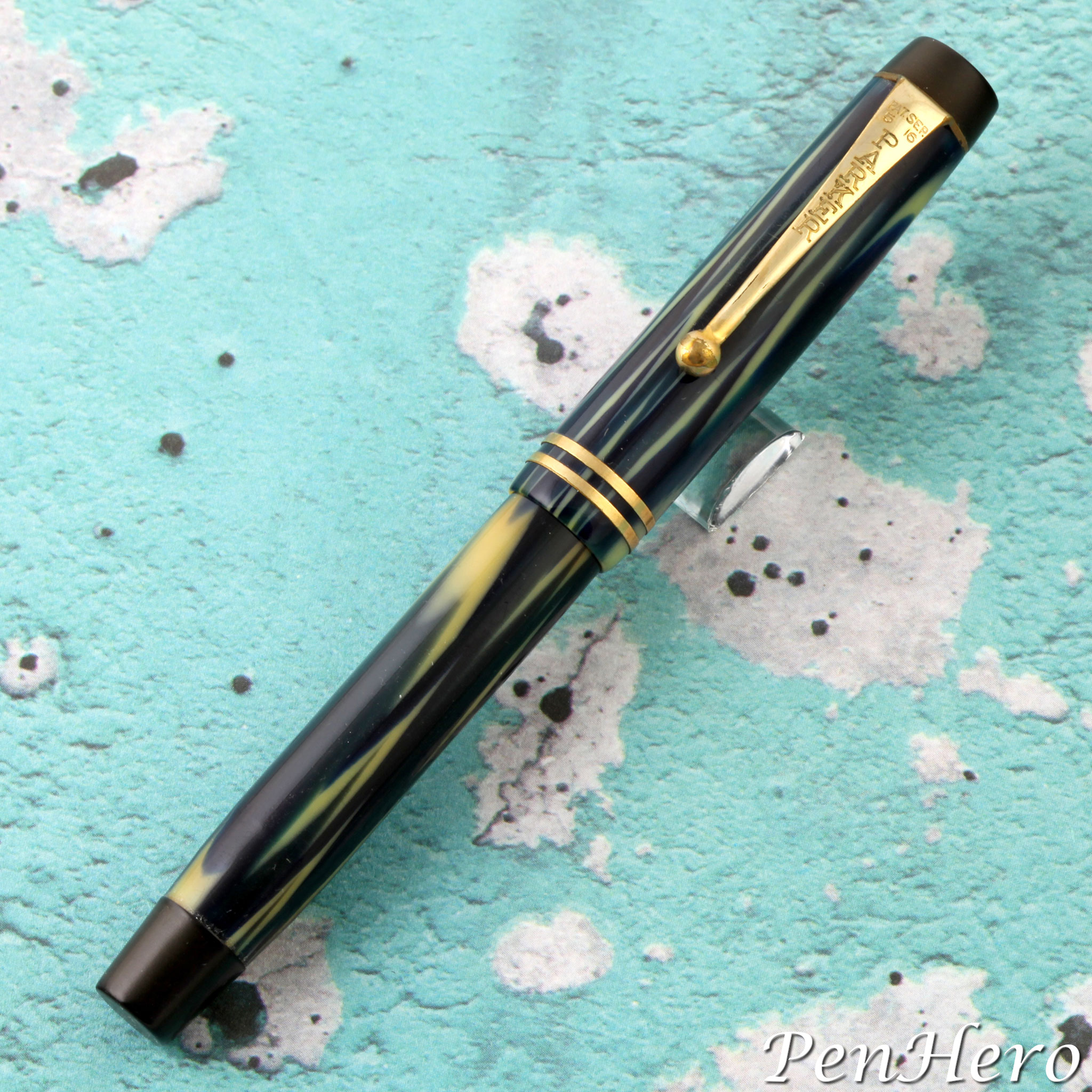 Parker True Blue streamlined junior size pen
Parker True Blue streamlined junior size pen
The True Blue uses Parker's button filling system, introduced in 1916. The advantage of the system is that the pen barrel is unbroken, with no lever or other device to snag clothes and pockets. The disadvantage is there is a blind cap to lose, and pens can be found without them. The button filling system is very simple to use. The process is straightforward: remove the blind cap from the bottom of the barrel, dip the nib in ink, press the button once, count to ten, and remove the nib and wipe. All filled nicely.
All wrote well. The fit and finish is excellent, except for discoloration and normal plating loss. They appear to be very durable and do not show any sign of being overly fragile. It’s nice to see a 1920s Parker pen with a flexible nib!
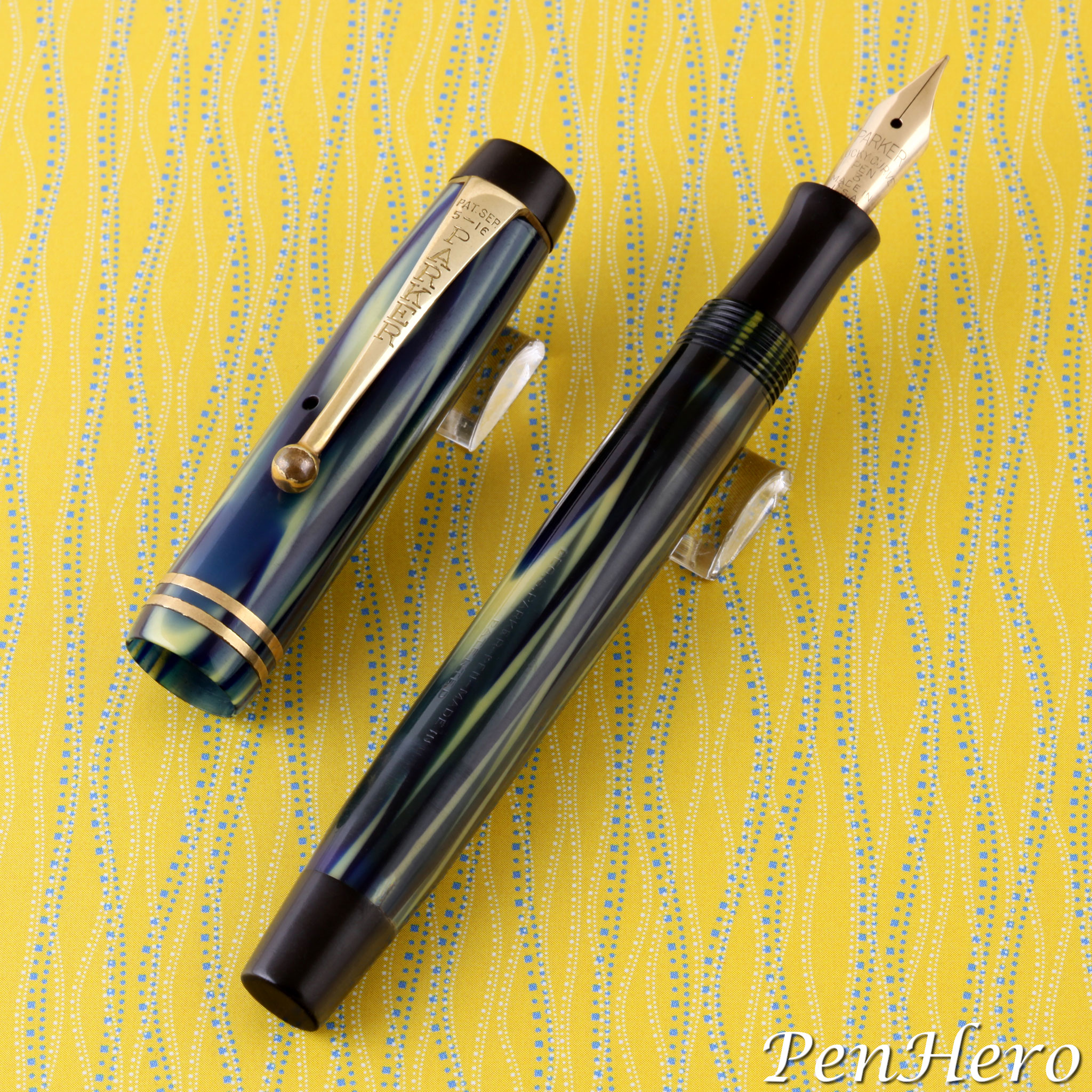 Parker True Blue streamlined junior size pen
Parker True Blue streamlined junior size pen
True Blues are very collectible, sought after, and the better the color the higher the price. A complete collection would be a pricey investment, but to me these are some of the best looking Parker pens of the 1920s.
Acknowledgement
Thanks to Daniel Kirchheimer for providing the "Parker Pen Fall Advertising Plans" article in the September, 1928 Geyer's Stationer that gives the fall 1928 start for the True Blue pens.
References
Advertisement, Boy's Life, June 1930, page 44
Advertisement, Boy's Life, September 1930, page 46
Advertisement, Joplin Globe, December 9 1928, page 12
Advertisement, News-Journal, December 21, 1930, page 13
Advertisement, Pittsburgh Sun-Telegraph, May 19, 1929, page 99
Advertisement, The Belgrade Herald, April 2, 1931, page 8
Advertisement, The Huntington Herald, August 30, 1926, page 27
Advertisement, The Ottawa Campus, July 16, 1923, page 3
Advertisement, The Windsor Star, December 14, 1929, page 50
Parker “DQ,” Black Line, Parker X, Raven, “School pens” 1924-1933, by Tony Fischier, © 1995-2019 Tony Fischier and The Parker Pen Company
Parker Duofold Pens, Pencils, Desk Sets (1930 Catalog), The Parker Pen Company, Janesville, Wisconsin, June 11, 1929 – page 15
Parkergrams, Volume XIX, No. 7, June 1931, page 18
"Parker Pen Fall Advertising Plans" Geyer's Stationer, September, 1928, page 66
Parker Pens, Pencils, Desk Sets (1929 Catalog), The Parker Pen Company, Janesville, Wisconsin, June 11, 1929
Interact
Comments on this article may be sent to the author, Jim Mamoulides


